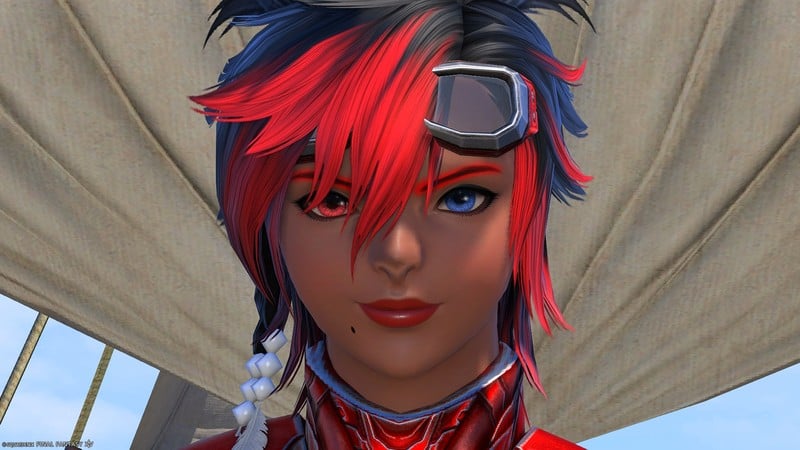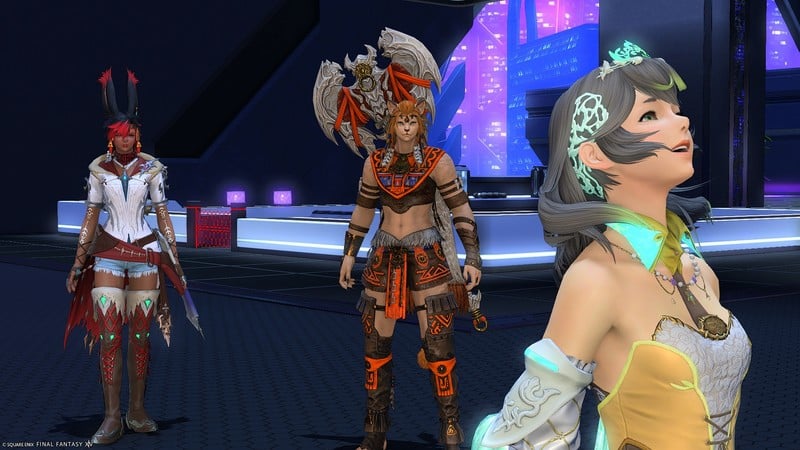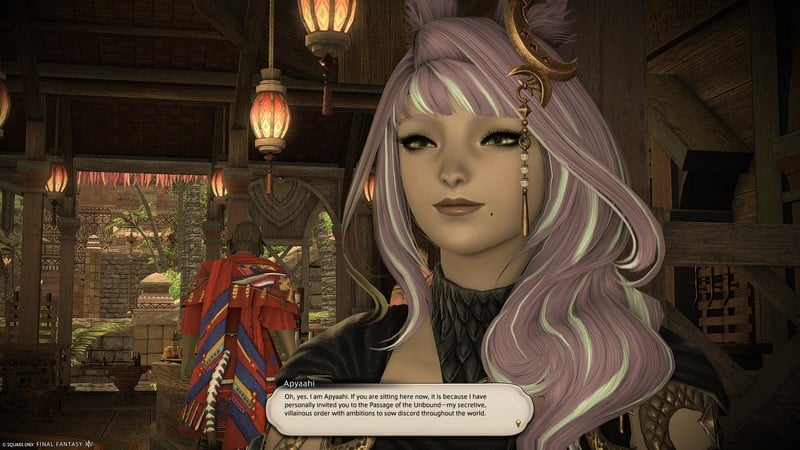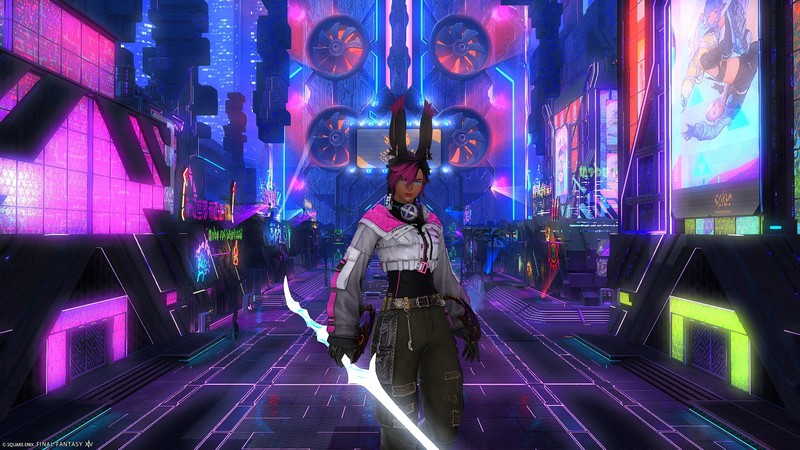Game Review
by Richard Eisenbeis,Final Fantasy XIV: Dawntrail
PC (Played), Mac, PlayStation 5, PlayStation 4, Xbox Series S/X, Xbox One
| Description: |  |
||
The Ascians are gone, the Empire has fallen, and the Endsinger has been pacified. In this, the fifth expansion to Final Fantasy XIV, the world is finally at peace and no longer needs its hero to protect it. Thus, the Warrior of Light heads off to the New World to take part in a series of quests and trials to help young princess Wuk Lamat prove herself worthy of her father's throne. At the end of this journey lies the fabled city of gold—and with it, the start of a whole new adventure. |
|||
| Review: | |||
From the very moment of its conception, Dawntrail was in a tough spot. With Endwalker, Final Fantasy XIV reached the narrative conclusion to the story it had been telling for 11 years. This left Dawntrail tasked with re-starting the story—becoming the foundation for the next decade-spanning epic. To do this, the creators focused on returning to basics. What were our player characters before they were the Warrior of Darkness, the Warrior of Light, or even the Champion of Eorzea? A simple adventurer—and that's what we return to being. We travel to a new continent full of exploration and mystery for fun.  In concept, this is a decent idea. In practice, however, it's much harder to pull off. After all, our character has traveled to other realities and the literal end of the universe. A new continent—especially one modeled after something as familiar as North and South America—is hardly the most exotic location in comparison. It also leaves us without a clear goal—or at least none that we have any kind of a personal stake in. The overall result is an expansion that feels like two separate games instead of a cohesive whole. The first is one that often feels like boring fluff—unless copious amounts of world-building and exploration for its own sake are what you're looking for in a game like this. The places you go to and the events you are caught up in have nothing to do with your character—and only a tenuous connection to keeping the world in the state of relative peace it's currently experiencing. Meanwhile, the second half of the game is much more what we've come to expect from Final Fantasy XIV. Suddenly we have an adventure with much greater ties to the lore of past expansions—and one with otherworldly locations, a nuanced villain, and a heartbreaking ethical dilemma at its core. The only real problem is the fifty hours of Dawntrail you must get through to even start it.  With all that said, it's finally time to address the elephant in the room: Wuk Lamat. Make no mistake, this game lives or dies on how much you enjoy spending time with her. Hers is a journey from a naive innocent who thinks she understands her lands and people to a person who would make a good ruler. And your job? To babysit her the whole damn way. To be clear, I don't hate Wuk Lamat. I find her rather endearing in small doses. I hate that she is the sole focus of nearly all character development among our heroes in the entire game. None of the characters we've been with for a decade grow in any way this expansion. Even Krile, who has a personal reason to travel to the New World, comes out of the expansion unchanged. However, the even bigger problem with Wuk Lamat comes with her placement in the plot. She is, unequivocally, the main character of Dawntrail—leaving you as little more than a side character in her story. Now, to be clear, this isn't inherently a bad thing. After all, you've traveled to the end of the universe and fought the personification of despair while riding through space on the back of a dragon (who's also your  Within the contents of the story, every test or trial Wuk Lamat comes across could be solved easily by you. At this point, you are a walking WMD. The other Scions have their unique roles—scouting, research, diplomacy, and leadership. Your job is to punch gods in the face until they explode into a mist of pretty particles. Of course, the trick in Dawntrail is that these trials and tribulations need to be solved by Wuk Lamat, not you. You are expected to stand back and follow her lead. It's a good way of limiting your impact on the story—giving you a believable reason why you don't just smash your way to victory at every given opportunity. Wuk Lamat needs to grow and learn—and to make her own mistakes to become who she needs to be. However, the issue is that her central role in the story continues even after your job babysitting her has ended. She inserts herself into nearly every fight and meaningful conversation. Her relationships with the various villains prevent you from making any real connection to them of your own. And to cap everything off, there's only one time in the entire expansion where it feels like it's finally your turn to take the stage—and Wuk Lamat still manages to burst in and make it about her. Her presence is so smothering that it becomes frustrating to the extreme.  The main sidequests of the game—the Role Quests—on the other hand, are enjoyable from beginning to end. They center around an evil secret society who have stolen powerful artifacts from the New World. The twist is that they're all losers—too focused on their petty ambitions to do any real harm to the world at large. So what you get from these quests is a series of stories filled with comedy and drama—and a cast of new characters all more enjoyable to spend time with than Wuk Lamat (especially Kuiyki). Of course, the story is only half of the Final Fantasy XIV experience. So how do things fair in the gameplay department? Dungeons are a solid mix of improvements mixed with some liberal application of the old rule of "if it's not broke, don't fix it." The basic dungeon design is largely the same: two groups of monsters, a barrier, then two more, and a boss. Repeat this two more times and you have a dungeon. There's a clear step up in the visual design of the dungeons as a whole—with more dynamic movement of the environment than ever before. But where the dungeons shine is in the boss battles. The bosses have been kicked up a notch in both difficulty and design. There's much more focus on special awareness and memory than in previous expansions. There are also a ton of new kinds of attacks—but the visual design allows you to understand them either right away or after seeing them once. Because of this, all felt challenging and surprising yet never took more than a try or two to defeat for the first time. This basic design philosophy carries over onto the trials and raids (on their normal difficulties). You are expected to have a good grasp on the core mechanics at this point so you can handle several at once—and often a never-before-seen one on top of that. The raid's setting is also a ton of fun as it frames each fight as if it's a professional wrestling match—which adds a ton of style to each battle and how they unfold.  Dawntrail also comes with two new jobs, the Viper and Pictomancer. As a Tank/Healer player mainly, I only spent a few hours with each of these but found both relatively enjoyable. Viper feels almost like a mix between Dancer and Samurai while Pictomancer does a good job of making you juggle several different mechanics at once in a way that feels largely new. Beyond the new job, every other job received at least a few additions—while some got massive changes. Among the jobs I leveled to 100 (Paladin, Astrologian, Sage, Dancer, Samurai, Black Mage), I found all as enjoyable as I had in previous expansions—except one. The rework of Astrologian's card system simplifies its gameplay to the point of boredom. Most of the cards feel like redundant healing options and drawing them so rarely makes it feel like they have far less impact on the battle than before. I leveled Sage just because I got sick of Astrologian so quickly. All in all, to call Final Fantasy XIV: Dawntrail a mixed bag is an understatement. For the first time since starting the game, I found myself not interested in continuing the main story during the first half of the expansion. It felt like a chore more than anything else. While this abated in the second half, the feeling of being on someone else's adventure never went away—and the game is worse for it. However, thanks to the nuanced villains, complex boss battles, and great music, I still had a ton of fun with this expansion. I hope that the upcoming patches learn from Dawntrail's weaknesses and continue to improve on its strengths.  Now, if you'll excuse me, I need to get back to grinding for the Vanguard gear so I can face upcoming patches in style. |
| Grade: | |||
|
Overall : B-
Graphics : B+
Sound/Music : A
Gameplay : B+
Presentation : C+
+ Enjoyable second half with a nuanced villain and heartbreaking ethical dilemma. Challenging boss design. |
|||
| discuss this in the forum (7 posts) | | |||